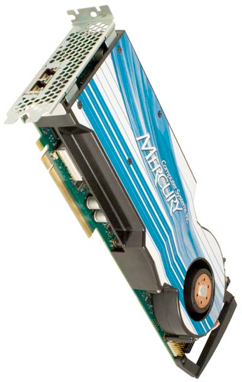Equipment

Accelerators

Center for Computation & Technology
Lab19 Johnston Hall, Baton Rouge, LA 70803
E-mail: GoPX@cct.lsu.edu
-
•Xilinx Virtex-4 XC4VFX60-11FF1152 FPGA
-
•PCI-Express x8 end-point edge connector
-
•Two SFP module connectors
-
•SATA host connector
-
•Five general-purpose Rocket I/O™ MGT ports
-
•Programmable LVDS clock generators
-
•On-board 100 MHz LVTTL oscillator
-
•On-board LVTTL oscillator socket
-
•User clock inputs via differential SMA connectors
-
•16M x 32 DDR SDRAM
-
•8M x 16 Flash
-
•EXP expansion slot
-
•10/100/1000 Ethernet PHY
-
•Platform Flash configuration memory
-
•JTAG programming/configuration port
-
•CPU JTAG/debug/trace ports
-
•SystemACE interface
-
•RS-232 serial port
-
•USB 2.0 interface
-
•User switches and LEDs
FPGA Boards
Avnet Virtex 4 PCIe

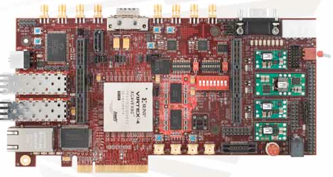
-
•XC5VSX50TFFG1136
-
•DDR2 SODIMM (256 MB)
-
•ZBT SRAM (1 MB)
-
•Linear Flash (32 MB)
-
•System ACE™ CF (CompactFlash) interface
-
•Platform Flash
-
•SPI Flash
-
•JTAG Programming Interface
-
•External Clocking (2 Differential Pairs)
-
•USB (2) – Host and Peripheral
-
•PS/2 (2) – Keyboard, Mouse
-
•RJ-45 – 10/100/1000 Networking
-
•RS-232 (Male) – Serial port
-
•Audio In (2) – Line, Microphone
-
•Audio Out (2) – Line, Amp, SPDIF, Piezo Speaker
-
•Rotary Encoder
-
•Video Input
-
•Video (DVI/VGA) Output
-
•Single-Ended and Differential I/O Expansion
-
•GPIO DIP Switch (8), LEDs (8), and Pushbuttons (5)
-
•MII, GMII, RGMII, and SGMII Ethernet PHY Interfaces
-
•PCI Express® Edge Connector (x1 Endpoint)
-
•GTP: SFP (1000Base-X)
-
•GTP: SMA (RX and TX Differential Pairs)
-
•GTP: SGMII
-
•GTP: PCIe®
-
•GTP: SATA (Dual Host Connections)
-
•GTP Clock Synthesis Chips
-
•Header for 2nd Serial Port
-
•2nd Platform Flash PROM (32 Mb) for large device
-
•Mictor Trace Port
-
•BDM Debug Port
-
•Soft Touch Port
Xilinx Virtex 5 ML506

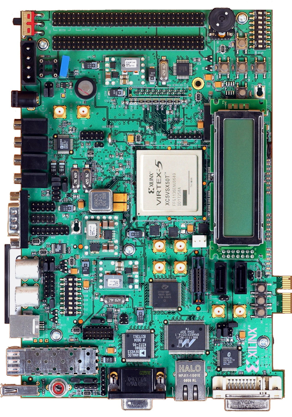
-
•XC5VFX70TFFG1136
-
•DDR2 SODIMM (256 MB)
-
•ZBT SRAM ( 1 MB)
-
•Linear Flash ( 32 MB)
-
•System ACE™ CF technology (CompactFlash)
-
•Platform Flash
-
•SPI Flash
-
•JTAG programming interface
-
•External clocking (2 differential pairs)
-
•USB (2) – host and peripheral
-
•PS/2 (2) – keyboard, mouse
-
•RJ-45 – 10/100/1000 networking
-
•RS-232 (Male) – serial port
-
•Audio In (2) – line, microphone
-
•Audio Out (2) – line, amp, SPDIF, piezo speaker
-
•Rotary encoder
-
•Video Input
-
•Video (DVI/VGA) output
-
•Single-ended and differential I/O expansion
-
•GPIO DIP switch (8), LEDs (8), and push buttons (5)
-
•MII, GMII, RGMII, and SGMII Ethernet PHY interfaces
-
•PCI Express® edge connector (x1 Endpoint)
-
•GTX: SFP (1000Base-X)
-
•GTX: SMA (RX and TX differential pairs)
-
•GTX: SGMII
-
•GTX: PCIe™
-
•GTX: SATA (dual host connections)
-
•GTX clock synthesis chips
-
•Header for second serial port
-
•Second Platform Flash PROM (32 Mb) for large device
-
•Mictor trace port
-
•BDM debug port
-
•Soft touch port
Xilinx Virtex 5 ML507

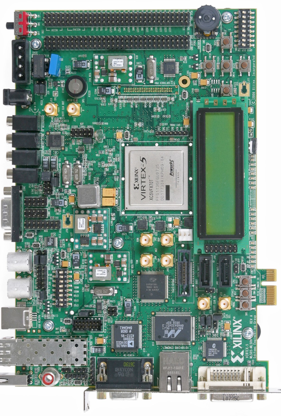
-
•Virtex-5 LXT XC5VLX50T-1FF1136 FPGA
-
•Serial Connectivity:
- PCIe: 8-lane add-in card connector
- SFP: 2 transceiver module ports (SFP modules not included)
- SATA: 1 Serial ATA disk drive interface connector (SATA cable not included)
- SMA: 1 SMA port for off-board GTP transceiver connectivity
- USB: 1 USB 2.0 port (USB interface cable not included) -
•Parallel Connectivity:
- PCI / PCI-X: 64-bit 3.3V add-in card connector
- LVDS: 2 SAMTEC LVDS interface connectors with up to 24 high-speed channels each -
•Additional Connectivity:
- Xilinx Generic Interface (XGI) headers support installation of Xilinx Ethernet PHY daughter card (sold separately) for 10/100/1000 Mb Ethernet connectivity -
•Memory Resources:
- 200-pin 1.8V SODIMM socket with 256 MB (32M x 64 bit) DDR2 SDRAM -
•Device Configuration
- Static or dynamic device reconfiguration support with the XC2C32 CoolRunner™-II CPLD
- Device configuration through on-board Platform Flash, or download using Xilinx Platform Cable USB -
•Xilinx LogiCORE™ IP supported:
- PCI Express endpoint designs in X1, X2, X4, and X8 configurations
- PCI-X 64b @ 66/100/133 MHz
- PCI 32b @ 33/66 MHz, 64b @ 33 MHz -
•Clocking:
- Three on-board clock sources, two differential SMA clock inputs
- Two programmable clock synthesizer chips to support DDR2 memory interfaces, 10/100/1000 Mb Ethernet protocols, SATA, Fibre Channel, Aurora, and other serial GTP baud rates
- PCI clocking support for global and regional clocking applications -
•Misc:
- User pushbutton switches and LEDs
- On-board power regulators (3.0V PCI, 2.5V, 1.8V, 1.0V, 0.9V VTT)
Xilinx Virtex 5 ML555

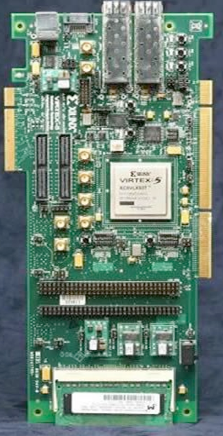
-
•The Spartan™-3 PCI Express® Starter Kit is a complete development board solution giving designers instant access to the capabilities of the Spartan-3 family and the Xilinx PCI Express Core.
-
•Lowest risk path for high-volume applications
-
•Full compliance with PCIe™ spec v1.1
-
•x1 PIPE IP with NXP PHY
Xilinx Devices:
-
•Spartan-3 (XC3S1000-4FG676C)
-
•Platform Flash (XCF08P-VO20C)
-
•Clocks: 50 MHz crystal clock oscillator
-
•Memory: 32MB x 32 DDR SDRAM
-
•Connectors and Interfaces:
-
•Philips PCI Express SerDes PX1011A
-
•PCI Express X1 card edge
-
•RS-232 serial port
-
•Four slide switches
-
•Eight individual LED outputs
-
•Two momentary-contact push buttons
-
•Video DAC
Xilinx Virtex 5 ML555

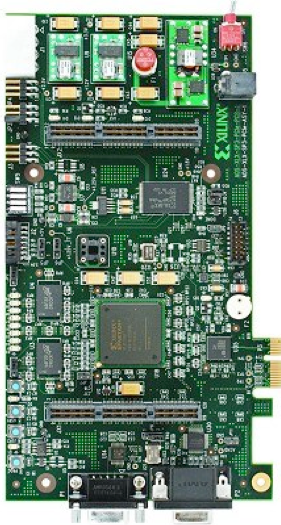
The RPU110-L200 includes an independent memory controller that provides greater memory bandwidth for maximum data flow. It also incorporates the largest FPGA available to deliver the greatest usable logic capacity for improved code efficiency and accelerated performance of compute-intensive applications. DRC’s RPU110–L200 module plugs directly into an open processor socket in a multi-way AMD Opteron™ system to provide direct access to adjacent double data-rate (DDR) memory and Opteron processors at HyperTransport™ speed and nanosecond latency. This tight coupling between the central processing unit (CPU) and memory eliminates bandwidth and latency issues and provides a general purpose system with supercomputer capability by running computations in hardware. Resulting speeds can be 10 to 20 times faster than if the subroutines were run in software. In addition, the RPU110-L200 is inherently efficient, requiring less power and space and reducing the number of nodes required to do the same work. DRC’s RPU110-L200 reduces power consumption, heat emissions, and space requirements in today’s data centers and delivers significant performance gains through RPU acceleration. The RPU110-L200 features on-board DDR2 memory, any of three HyperTransport bus interfaces and the largest FPGAs on the market, including the Xilinx Virtex™-4 LX160, and Virtex-4 LX200 FPGAs. The
RPU110-L200 enables greater application acceleration in three ways: first, with three times more compute resources in the L200, more of any given application can run on the RPU; second, with 2GB of
on-board RPU memory plus the 8GB of motherboard memory, the RPU110-L200 delivers more than 17GB/second of system memory bandwidth, three times the stand-alone CPU bandwidth; and third, up to 3.2GB of usable system bus bandwidth is now available.
DRC RPU110-L200

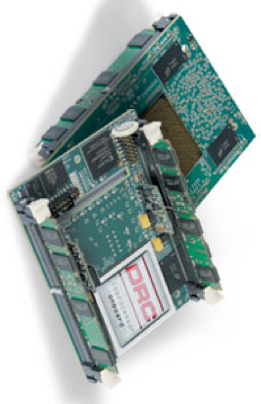
ClearSpeed
X620 PCI-X board

•96 high-performance processing elements cores, each
with dedicated memory
• 6 Kbytes high bandwidth memory per processing
element
• 128 Kbytes on-chip scratchpad memory
• 64-bit DDR2 DRAM interface with ECC support
• ClearConnect provides on-chip and inter-chip
data network
• Host interface and debug port
• 64-bit virtual, 48-bit physical addressing
• On-chip instruction and data caches
• On-chip DMAcontroller
• 10W average power dissipation
• 25 GFLOPS sustained double precision DGEMM
• 250K 1,024-point complex floating point FFTs/second
• 96 Gbytes/s internal memory
• 3.2 Gbytes/s external memory
• 2 x 3.2 Gbytes/s chip-to-chip bandwidth
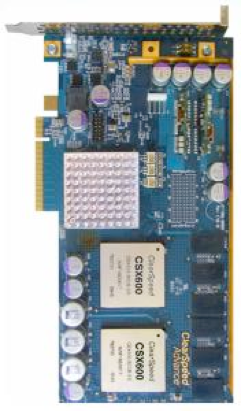
X620 PCI-X board

The ClearSpeed Advance e710 is the latest accelerator to bring all the benefits of ClearSpeed's technology to the newest generation of multi-core industry standard servers. It delivers new levels of compute performance, reliability, precision and accuracy for high performance computing (HPC) applications in financial services and a wide variety of scientific disciplines.
The Advance e710's compact size and low power consumption enable it to be installed quickly and easily into industry standard servers, without requiring any additional cooling or power supplies. The low profile PCIe x8 board includes one ClearSpeed CSX700 and 2 GBytes of ECC-protected DRAM.
The small size and low power dissipation of the ClearSpeed Advance e710 with the new PCIe switch technology, opens the way to dense, low power, peta-scale computation. The low-profile format of the e710 enables boards to be densely integrated vertically in a 2U server chassis. The ClearSpeed CATS-700 integrates 12 e710 boards using PCIe Gen1 switches within a 1U enclosure. By using the latest Gen2 PCIe switches devices, larger and/or higher bandwidth aggregations are possible.
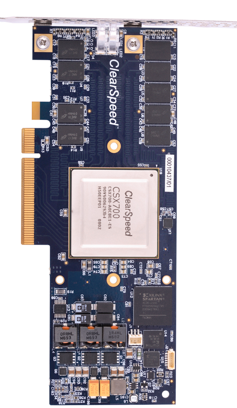
MC Cell BE board
Mercury Computing Cell BE Board

-
•More than 180 GFLOPS in a PCI Express® accelerator card
-
•One Cell BE processor running at 2.8 GHz
-
•PCI Express x16 channel
-
•Dual Gigabit Ethernet ports
-
•Optional MultiCore Plus Cell SDK
-
✤Cell BE Processor
PPE core: IBM® 64-bit Power Architecture™
L1 cache size: 32 KB instruction; 32 KB data
L2 cache size: 512 KB
SPEs: 8
Local store: 256 KB
Registers: 128 x 128 bits wide
EIB: 180 GB/s sustained aggregate bandwidth
Processor internal clock speed: 2.8 GHz
Processor-to-memory bandwidth: 22.8 GB/s
For more information regarding this product, visit this link: Product Information
